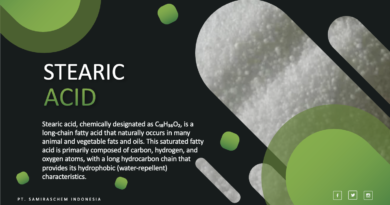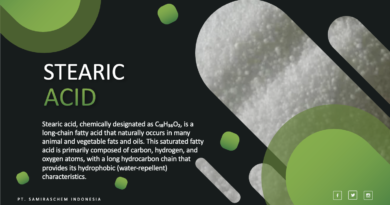Stearic Acid Structure
Stearic Acid Structure – Stearic acid is a long-chain saturated fatty acid with the chemical formula C₁₈H₃₆O₂. It is widely used in industries such as cosmetics, pharmaceuticals, and food manufacturing due to its stability and unique physical properties. This compound is a type of carboxylic acid and belongs to the group of fatty acids that are vital to both biological processes and industrial applications. Its structure, consisting of a hydrocarbon chain and a carboxyl group, plays a crucial role in determining its chemical behavior and functionality. In this exploration, we’ll dive into the details of stearic acid’s molecular structure, including its composition, bonding, and relevance to its uses.
1. Basic Structure of Stearic Acid
The molecular formula of stearic acid is C₁₈H₃₆O₂, meaning it has 18 carbon atoms, 36 hydrogen atoms, and 2 oxygen atoms. Its structure is composed of two main parts:
- A Long Hydrocarbon Chain (C₁₇H₃₅): This chain is non-polar and hydrophobic, making stearic acid insoluble in water but soluble in organic solvents like ethanol and oils.
- A Carboxyl Group (-COOH): This group is polar and responsible for the acidic nature of stearic acid. It allows stearic acid to participate in various chemical reactions, including the formation of salts and esters.
The structural formula of stearic acid can be represented as CH₃(CH₂)₁₆COOH.
2. Detailed Breakdown
a. The Hydrocarbon Chain (C₁₇H₃₅)
The hydrocarbon chain is an unbranched chain of 17 carbon atoms, each connected to hydrogen atoms. It consists entirely of single bonds, making stearic acid a saturated fatty acid. Saturated fatty acids contain no double bonds between the carbon atoms in the chain, resulting in a straight and stable structure.
- Bonding and Shape: The carbon atoms in the chain are connected by single covalent bonds (sigma bonds). Each carbon atom in the chain forms four bonds (either with neighboring carbon atoms or with hydrogen atoms), creating a zig-zag shape typical of linear hydrocarbons. The lack of double bonds means that the chain remains straight and packed closely when in solid form.
- Hydrophobic Nature: The hydrocarbon chain is non-polar, which makes it water-repellent (hydrophobic). This property is essential in its role in emulsions and as a thickening agent in various products.
b. The Carboxyl Group (-COOH)
At one end of the stearic acid molecule is the carboxyl group (-COOH), which is polar and hydrophilic (water-attracting). The carboxyl group consists of a carbonyl group (C=O) and a hydroxyl group (-OH) attached to the same carbon atom.
- Acidic Nature: The -COOH group is what makes stearic acid an “acid.” When dissolved in a solution, the carboxyl group can release a hydrogen ion (H⁺), leaving behind a negatively charged carboxylate ion (COO⁻). This ability to donate a proton defines stearic acid as a weak acid.
- Polar Bonding: The oxygen atoms in the carboxyl group have a high electronegativity, which creates polarity in this part of the molecule. This polarity allows stearic acid to interact with polar molecules, even though the rest of the molecule is non-polar.
- Reactivity: The carboxyl group can participate in various reactions, such as the formation of esters and salts, which are useful in creating soaps, emulsifiers, and other industrial compounds.
3. Chemical Representation of Stearic Acid
Stearic acid is often represented in various forms to highlight different aspects of its structure:
- Molecular Formula: C₁₈H₃₆O₂ provides an overall count of the atoms.
- Condensed Structural Formula: CH₃(CH₂)₁₆COOH. This notation shows the arrangement of atoms in groups, which provides insight into the length of the hydrocarbon chain and the position of the carboxyl group.
- Skeletal Formula: This is a simplified diagram where each vertex represents a carbon atom, and lines between vertices represent bonds. The carboxyl group (-COOH) is shown at one end of the molecule.
4. Bonding and Polarity in Stearic Acid
a. Covalent Bonds
The carbon atoms in stearic acid are linked by single covalent bonds, which are relatively stable and make the compound resistant to oxidation compared to unsaturated fatty acids.
- Sigma Bonds: The single bonds between carbon atoms are sigma (σ) bonds, which are strong and provide a stable structure.
- Lack of Pi Bonds: Unlike unsaturated fatty acids, stearic acid has no pi (π) bonds, as there are no double bonds. This absence of double bonds contributes to its solid state at room temperature and gives it a high melting point (69-70°C).
b. Polarity
The molecule has both polar and non-polar regions:
- Non-Polar Hydrocarbon Chain: The long carbon chain is non-polar and hydrophobic, making stearic acid poorly soluble in water.
- Polar Carboxyl Group: The -COOH group at the end of the chain is polar, allowing stearic acid to interact with polar solvents and enabling it to participate in reactions like saponification.
5. Physical Properties of Stearic Acid Related to Its Structure
The structure of stearic acid plays a significant role in determining its physical properties, which include:
- Melting Point: Stearic acid’s straight-chain structure, due to its saturated bonds, allows molecules to pack closely in a solid lattice, resulting in a relatively high melting point of around 69-70°C.
- Solubility: Due to the large non-polar hydrocarbon chain, stearic acid is insoluble in water but soluble in organic solvents like ethanol and chloroform.
- Solid Form: Stearic acid is a solid at room temperature due to its long, saturated hydrocarbon chain, which provides rigidity and allows the molecules to stack in an orderly fashion.
6. Role of Stearic Acid’s Structure in Chemical Reactions
Stearic acid’s structure, particularly its carboxyl group, allows it to participate in key chemical reactions that make it useful in various applications:
a. Saponification
Saponification is a reaction where stearic acid reacts with a strong base (like sodium hydroxide) to form a soap, specifically sodium stearate. This process is fundamental in soap-making:
- The polar carboxyl group reacts with the base, releasing a water molecule and forming the salt (sodium stearate), which has both hydrophilic and hydrophobic properties, making it an effective surfactant.
b. Esterification
In esterification, stearic acid reacts with alcohols to produce esters, which are useful in cosmetics and industrial applications:
- For example, when stearic acid reacts with glycerol, it forms glyceryl stearate, a common emulsifier in skincare products.
7. Importance in Industrial Applications
The structure of stearic acid makes it ideal for a variety of roles in manufacturing and consumer products:
- Cosmetics and Personal Care: Its hydrophobic chain and stable carboxyl group allow it to act as a thickening agent, emulsifier, and emollient in lotions, creams, and balms.
- Pharmaceuticals: Stearic acid’s structure allows it to function as a lubricant in tablet manufacturing, ensuring tablets maintain their shape and consistency.
- Food Industry: In foods, stearic acid is used as a hardening agent, particularly in confectionery products, due to its high melting point and stable structure.
8. Biological Relevance of Stearic Acid’s Structure
In biological systems, the structure of stearic acid contributes to its role as a building block in cell membranes and as a source of energy:
- Cell Membrane Composition: The hydrocarbon chain of stearic acid helps form the lipid bilayer in cell membranes, maintaining membrane fluidity and stability.
- Energy Storage: Stearic acid can be broken down to produce ATP in cells, serving as a source of energy.
9. Conclusion: Defines Its Functionality
The structure of stearic acid—a long, saturated hydrocarbon chain with a terminal carboxyl group—defines its physical and chemical properties, making it a versatile fatty acid in various industries. Its structure allows it to function as an emollient, emulsifier, thickener, and lubricant, making it invaluable across cosmetics, pharmaceuticals, and food production. Understanding stearic acid’s structure provides insight into its stability, insolubility in water, and its ability to interact in chemical reactions that produce valuable derivatives for many applications.






